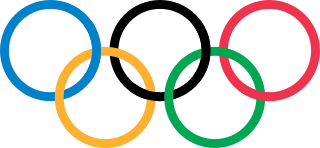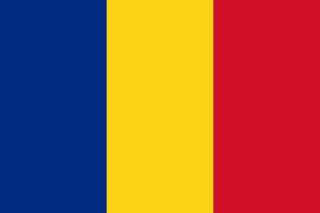
Basketball at the 1936 Summer Olympics was the first appearance of the sport of basketball as an official Olympic medal event. The tournament was played between 7 August and 14 August 1936 in Berlin, Germany. 23 nations entered the competition, making basketball the largest tournament of the team sports, but Hungary and Spain withdrew, meaning 21 competed.
The men's team sabre was one of seven fencing events on the Fencing at the 1928 Summer Olympics programme. It was the fifth appearance of the event. The competition was held from 8 August 1928 to 9 August 1928. 65 fencers from 12 nations competed.
The men's team épée was one of seven fencing events on the fencing at the 1936 Summer Olympics programme. It was the seventh appearance of the event. The competition was held from 7 August 1936 to 8 August 1936. 108 fencers from 21 nations competed. Each team could have a maximum of six fencers, with four participating in any given match.
The men's team foil was one of seven fencing events on the fencing at the 1936 Summer Olympics programme. It was the sixth appearance of the event. The competition was held from 2 to 4 August 1936. 99 fencers from 17 nations competed. Each team could have a maximum of six fencers, with four participating in any given match.
The men's team épée was one of seven fencing events on the fencing at the 1948 Summer Olympics programme. It was the eighth appearance of the event. The competition was held from 5 August 1948 to 6 August 1948. 113 fencers from 21 nations competed.
The men's team foil was one of seven fencing events on the fencing at the 1948 Summer Olympics programme. It was the seventh appearance of the event. The competition was held from 30 July 1948 to 31 July 1948. 82 fencers from 16 nations competed.
The men's team sabre was one of seven fencing events on the fencing at the 1948 Summer Olympics programme. It was the eighth appearance of the event. The competition was held from 10 August 1948 to 11 August 1948. 85 fencers from 17 nations competed.
The men's team sabre was one of seven fencing events on the fencing at the 1952 Summer Olympics programme. It was the ninth appearance of the event. The competition was held from 29 July 1952, to 30 July 1952. 85 fencers from 19 nations competed.
The men's team foil was one of seven fencing events on the fencing at the 1956 Summer Olympics programme. It was the ninth appearance of the event. The competition was held 23 November 1956. 50 fencers from 9 nations competed.
The men's team épée was one of seven fencing events on the fencing at the 1956 Summer Olympics programme. It was the tenth appearance of the event. The competition was held on 28 November 1956. 55 fencers from 11 nations competed.
The men's team sabre was one of seven fencing events on the fencing at the 1956 Summer Olympics programme. It was the tenth appearance of the event. The competition was held on 3 December 1956. 43 fencers from 8 nations competed.
The men's team foil was one of eight fencing events on the fencing at the 1960 Summer Olympics programme. It was the tenth appearance of the event. The competition was held on 2 September 1960. 77 fencers from 16 nations competed.

The men's team épée was one of eight fencing events on the fencing at the 1960 Summer Olympics programme. It was the eleventh appearance of the event. The competition was held on 9 September 1960. 105 fencers from 21 nations competed.

The women's team foil was one of eight fencing events on the fencing at the 1960 Summer Olympics programme. It was the first appearance of the event. The competition was held on 3 September 1960. 57 fencers from 12 nations competed. The winner of the tournament was the Soviet Union, followed by Hungary and Italy in third.
The men's team foil was one of eight fencing events on the fencing at the 1972 Summer Olympics programme. It was the thirteenth appearance of the event. The competition was held from 1 to 2 September 1972. 63 fencers from 13 nations competed.
The men's team sabre was one of eight fencing events on the fencing at the 1976 Summer Olympics programme. It was the fifteenth appearance of the event. The competition was held from July 26 to 27, 1976. 63 fencers from 14 nations competed.
The women's team foil was one of eight fencing events on the fencing at the 1976 Summer Olympics programme. It was the fifth appearance of the event. The competition was held from 27 to 28 July 1976. 61 fencers from 13 nations competed.
The men's team sabre was one of eight fencing events on the fencing at the 1980 Summer Olympics programme. It was the sixteenth appearance of the event. The competition was held from 28 to 29 July 1980. 63 fencers from 8 nations competed.
The women's team foil was one of eight fencing events on the fencing at the 1980 Summer Olympics programme. It was the sixth appearance of the event. The competition was held from 26 to 27 July 1980. 43 fencers from 9 nations competed.

The Romania national football team represents Romania in international association football and is controlled by the Romanian Football Federation. Between their first official match in 1922 and 1939, when competitive football stopped for the Second World War, Romania played in 82 matches, resulting in 36 victories, 14 draws and 32 defeats. Throughout this period they played in the Balkan Cup six times between 1931 and 1936 with Romania taking home three titles in 1929–31, 1933 and 1936. Romania also qualified through to three FIFA World Cup's during the 1930s where they got eliminated in the first round in all three attempts with the national team finishing second in their group at the 1930 edition before being eliminated by Czechoslovakia (1934) and Cuba (1938) respectively in the following cups.




